THE
ROLE OF POLITICAL PARTIES
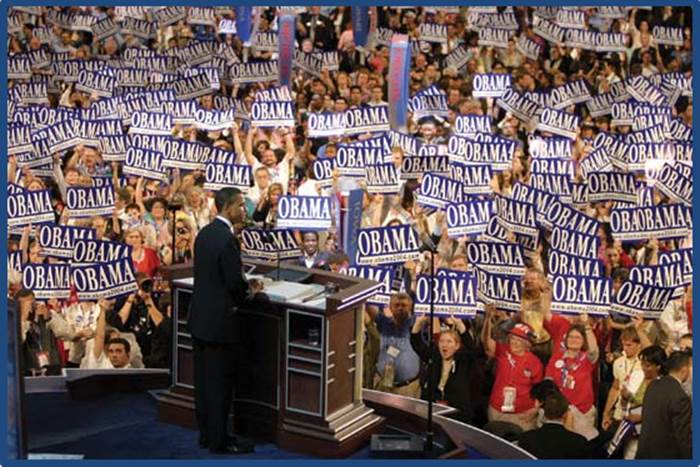
Barack Obama Speaking at
the Democratic National Convention
Overview
Although George Washington and other illustrious
Americans were critical of political parties, it is impossible to imagine the
democratic system of the United States without them. Political parties play a major role in the
process of government, the determination of policy and the formation of public
opinion. Citizens may have very little
power as individuals, but they can influence decisions through collective
action. By competing in elections and
energizing people, political parties expand participation in government and
shape the country’s future.
Functions of Political Parties
Political parties are groups of citizens who
organize to control government by winning elections and by shaping public
policies. In other words, they offer
ways for Americans to have a say in who serves in government and what issues
are addressed. These organizations have
become a major link between the citizens and the country’s leaders.
Political Parties and Government
One important function of a political party is the
recruitment and selection of competent leaders.
Candidates are typically nominated and elected to public office through
the work of political parties. Following
an election, these same groups play a major role in organizing and managing the
government. Party leaders set priorities
for making new laws and encourage support for the party’s positions on specific
issues. This happens on every level of
government. State legislatures as well
as Congress are structured along party lines; mayors, governors and Presidents
all appoint individuals from their own party to direct policies.
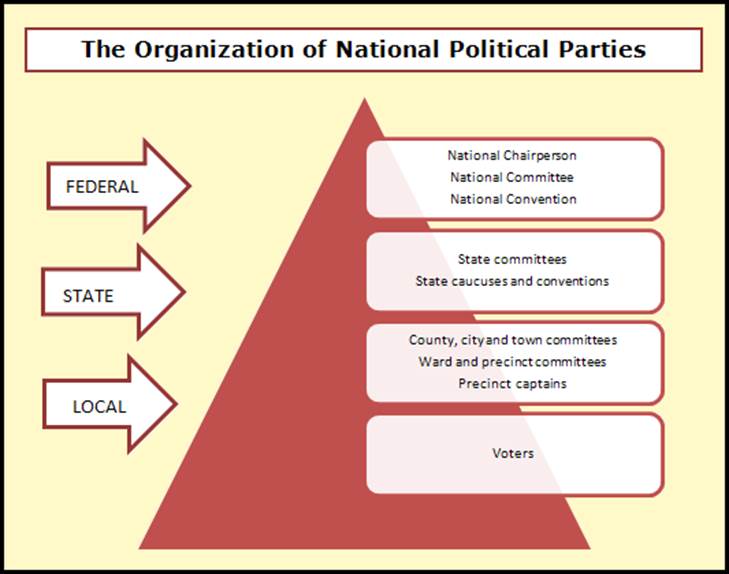
The party that loses the election, known as the opposition party, plays a significant
role, too. Their members, while loyal to
the national, state or local government, oppose the policies of the party in
power. The minority party checks the
dominance of the majority party informally by questioning decisions and
proposing alternative strategies and methods.
This interaction prevents one party from gaining too much
influence.
While the media and concerned citizens draw
attention to specific problems and issues, it is political parties that
transform these concerns into workable plans and practical programs through
government action. Parties also help
lawmakers with diverse viewpoints to make compromises and to reach
consensus. This brings people together
and reduces controversy. Political
parties sometimes arrange temporary alliances among groups that maintain
opposing opinions. This type of
agreement is referred to as a coalition and
is often used to win an election for a particular candidate. The New
Deal Coalition was formed by the Democratic Party and was first used to
support the election and programs of Franklin Roosevelt. It successfully united state party
committees, minorities, labor unions and farmers from the 1930s to the 1960s. Even
though it often seems that political parties keep the government from moving
forward, we have come to rely on them for getting things done.
 Go to Questions 1 through 4.
Go to Questions 1 through 4.
Political Parties and People
Aside from the actual workings of government,
political parties serve the general public in a number of ways. They sponsor political debates, campaign
rallies, press conferences, websites, newspaper ads and television talk
shows. Although it is important to
remember that the information presented in these formats is often biased in
favor of one party’s aims, these organizations do highlight and publicize
critical issues. Parties also conduct
opinion polls and surveys that reveal the concerns and priorities of U.S. voters.
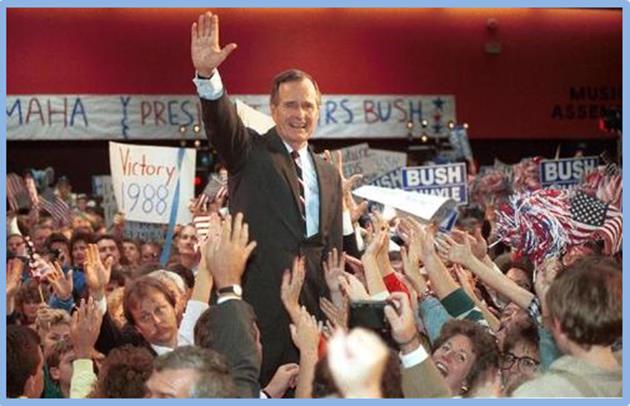
Republican Rally in Omaha, Nebraska
Along with presenting valuable information to the
public, political parties increase participation and interaction within the
democratic process. For instance, party
workers often conduct voter registration drives and supply services, such as
transporting people to the polls. Both
Democrats and Republicans sponsor clubs, like the Muleskinners Club (for
Democrats) and the Pachyderm Club (for Republicans), to create a greater
interest in politics and to promote discussions on significant issues. The use of the Internet by political parties
has also opened the lines of communication between citizens and their
government. Citizens can now easily
interact with party and government representatives through tweets, videos,
blogs, online petitions and social media posts.
For some voters, membership in a political party can
simplify the decision-making process.
Many citizens do not have the time or the patience to investigate the
qualifications and the positions of every candidate on the ballot. They do, however, know which party best
reflects their attitudes and visions for the future. Therefore, they vote for the candidates and
issues favored by their political party.
This is one way to deal with the vast amount of information and complex
ideas involved in government.
 Go to Questions 5 through 7.
Go to Questions 5 through 7.
The Two-party System
Although multi-party systems are common throughout the
world, the United States and other English-speaking countries have remained
true to their British roots and have adopted the two-party system. Minor parties have occasionally influenced
American politics, but two major parties have been consistently dominant. For the most part, Americans agree on many
fundamental values; this cuts down on the need for a larger number of political
parties to represent multiple viewpoints.
The Constitution itself makes no reference to political parties, but the
winner-take-all policy practiced in counting votes in the Electoral College has
contributed to the success of the two-party system. Since the election of 1860, the Democrats,
symbolized by the donkey, and the Republicans, symbolized by the elephant, have
accounted for ninety percent of the popular vote. Over time, American families have perpetuated
this system by teaching it as part of their family heritage. Federal and state laws have been passed to
ensure its stability, but this has also created legal barriers that make it
difficult to establish third parties.
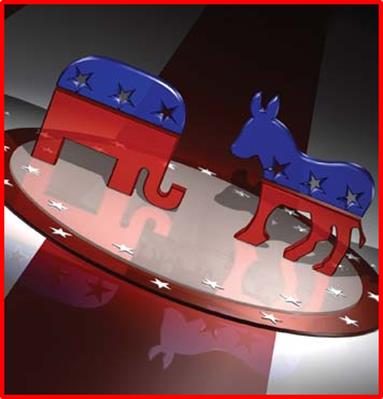
Political Party Symbols
 Go to Questions 8 and 9.
Go to Questions 8 and 9.
The Democratic Party v the Republican
Party
What makes a Republican a Republican? What makes a Democrat a Democrat? There are no simple answers to these
questions. This is true because,
although the major parties have real differences, they also have several
similarities. Anyone can become a member
of either of these parties by simply saying that they wish to do so. Unlike other organizations, there are no
membership fees or specific requirements.
Therefore, both parties serve a broad base of people from every economic
level and geographic area. This also has
encouraged the major political parties to encompass individuals from both the
conservative and liberal ends of the political spectrum within the same
party. In other words, the Republican
Party and the Democratic Party try to remain “middle-of-the-road” but still
attempt to appeal to constituents outside of the mainstream. Both parties maintain a national headquarters
and choose a national committee that has the responsibility for planning the
presidential nominating convention every four years. Along with raising funds for the campaign, the
national committee oversees the party platform. This document lists the specific goals which
the party hopes to accomplish through the election of their candidate. The two major parties also have committees in
each of the fifty states. Because these
organizations are controlled by state law, their structures vary. They work with local party committees to
raise money, to register voters and to recruit party candidates.
In spite of their similarities, there are clear
differences between Republicans and Democrats.
Most of their disagreements question the appropriate amount of
government intervention. To solve
problems effectively over the long term, Republicans generally favor less
government action and greater reliance on the private sector. Democrats, on the other hand, tend to rely
more on government action and less on the response of the private sector. Several other differences are noted on the chart
below. Keep in mind that these are only
generalizations and are not true for every Republican and every Democrat.
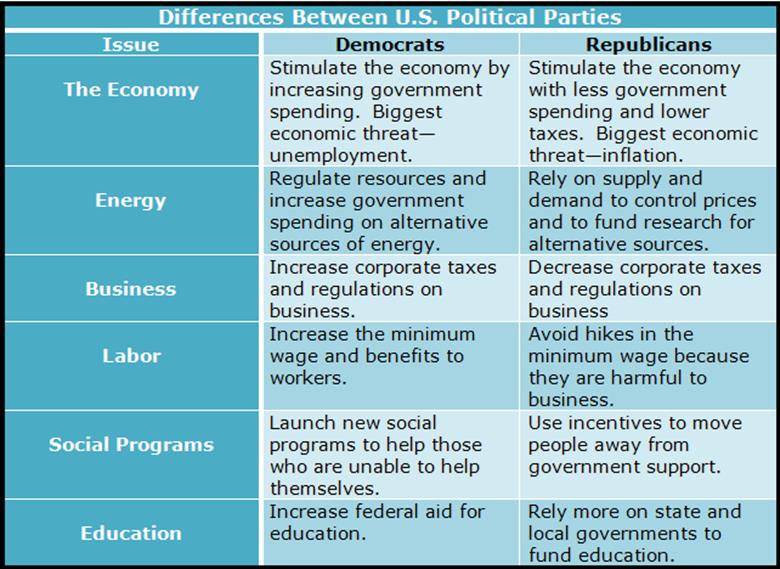
 Go to Questions 10 through 13.
Go to Questions 10 through 13.
Third Parties
Although their success has been limited due to legal
barriers and a lack of financial support, third
parties, also known as minor parties, do play a significant role in the
American political process. Sometimes
they offer new ideas and suggest changes that are eventually incorporated into
major party platforms. Occasionally, a
third party makes such a strong showing that it impacts a presidential election
by acting as a “spoiler”. For example,
Theodore Roosevelt ran as a candidate for the Bull Moose Party, which broke
away from the Republican Party in 1912.
Because Roosevelt received 27.4% of the vote, William Howard Taft, the
Republican candidate, lost the election to the Democratic nominee, Woodrow
Wilson. Most third parties fit into one
of three major categories: single-issue
parties, ideological parties and splinter parties.
Ø Single-Issue parties: Most third parties throughout United States
history have been formed to support social, economic or moral changes. For example, the Liberty Party, popular in
the era before the Civil War, promoted the anti-slavery cause. Once the specific issue has been resolved,
these parties frequently disappear. One
exception is the Prohibition Party, which continues to oppose the use and sale
of alcoholic beverages. This
organization still runs presidential candidates even though Prohibition has
been repealed by the Twenty-first Amendment.
Ø Ideological parties:
Parties
based on a particular ideology seek to change the underlying principles on
which our government is based. They
advocate long-range plans for the future and often represent political
philosophies that outside the mainstream.
The Communist Party, which encourages the overthrow of capitalism, and
the Libertarian Party, which demands less government intervention in the lives
of private citizens, are examples.
Ø Splinter parties:
When serious disagreements erupt within a major party, a group may break
away and form a splinter party. Such an
organization is often centered on a popular candidate that does not win the
support of the Democrats or the Republicans.
Dissatisfied Republicans left the party in 1912 and formed the Bull
Moose Party, which focused on Theodore Roosevelt. In 1968, the American Independent Party, made
up of Democrats who opposed their party’s civil rights platform, rallied around
George Wallace and supported his bid for the presidency.
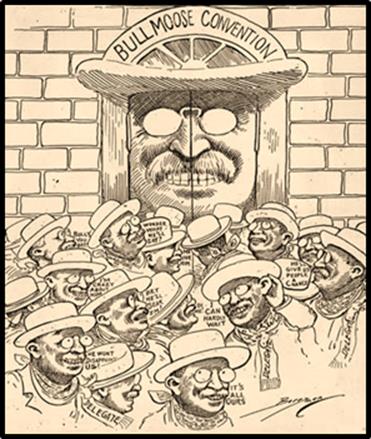
Cartoon Emphasizing Roosevelt's Role in the Bull Moose
Party
Even though third parties have failed to elect one
of their candidates to the presidency, they have sent members to Congress by
establishing strong bases in single states. One of the most successful third
parties on the state level is the Reform Party.
The organization first gained public support when Ross Perot attempted a
run for the presidency in 1992 and again in 1996. However, the party’s greatest success was
achieved when Jesse Ventura ran as a candidate for governor of Minnesota. In an unexpected victory, he defeated the
Democratic and Republican candidates by a narrow margin. The
chart below lists a few current third parties and gives a general overview of
their aims.
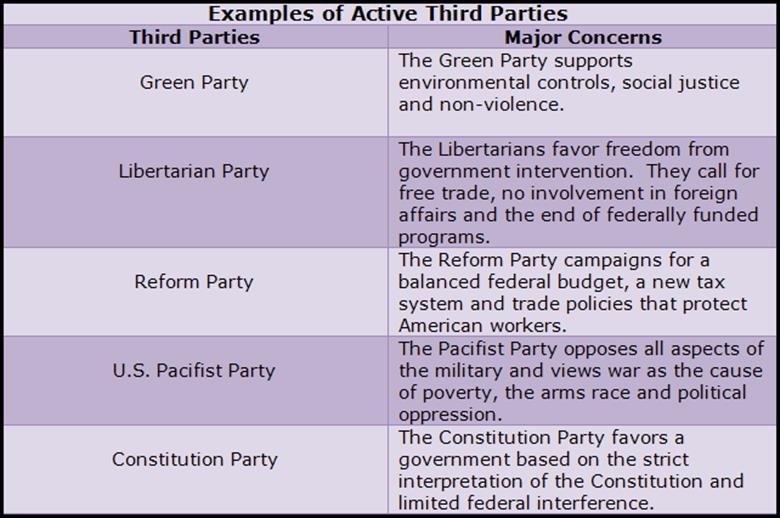
 Go to Questions 14 through 17.
Go to Questions 14 through 17.
The Future of Political Parties
Although political parties have become an integral
part of democracy as it is practiced in the United States, popular support for
both Democrats and Republicans has declined in recent decades. Traditional party loyalty is disappearing,
and this has caused voters to cast split
tickets rather than straight tickets. With a straight ticket, voters select all the
candidates from one party. With a split
ticket, they choose a combination of Democrats, Republicans and third party
candidates. There has also been an
increase in the number of voters who are registered as independents. This refers to
people that have not registered as members of any particular political
party. This group consisted of 20% of
the American electorate in the 1940s, but 30% of voters currently fall into
this category.
This shift is the result of several factors. For many years, government workers,
especially on the local level, were hired and fired when an administration
representing a different political party took office. This practice, known as patronage, has been increasingly replaced by civil service
examinations and laws prohibiting termination of employment based on party
affiliation. The methods of choosing
candidates and the funding of campaigns have also affected party
membership. Many states use direct
primaries based on popular vote to nominate candidates for public office. At one time, candidates relied on the
organizational skills of political parties to conduct campaigns. Today, many candidates hire their own public
relations directors and media specialists.
Financial contributions come from special interest groups and Political
Action Committees so office seekers are less dependent on the fund-raising
techniques supplied by political parties.
Does this mean that parties will disappear from the
political scene? It is unlikely. Parties are firmly entrenched in the American
political culture and continue to offer a means for the average citizen to have
a say in government. The organization of
the federal government, especially Congress, has come to depend on the concept
of a majority party and a minority party. The performance of Democrats and Republicans
in national elections determines House and Senate majority leaders, minority
leaders and committee chairpersons. Although Americans hold conflicting views
about its productivity, the two-party system in the United States seems to be
here to stay.
 Go to Questions 18 through 20.
Go to Questions 18 through 20.
What’s Next?
Political parties provide opportunities for citizens
to influence elections and public policy, but they are not the only ways to
impact policy decisions. Interest groups
also unite people who hold similar views on important public issues. In the next unit, you will look at what they
do and how they differ from political parties.
Before moving on, review Unit 12, and complete Questions 21 through 30.
 Go to Questions 21 through 30.
Go to Questions 21 through 30.

Below are additional educational resources and activities for this unit.